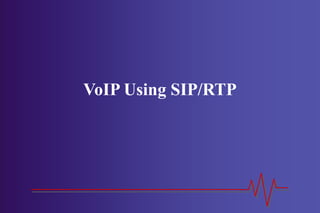
cs522_presentation.ppt
- 2. Two Parts of the Project • Understand VOIP • Implement SIP and RTP
- 3. Voice To/From IP Analog Digital Voice CODEC: Analog to Digital Compress Create Voice Datagram Add Header (RTP, UDP, IP, etc) Network
- 5. ISO Reference Model and VoIP Standards ISO Protocol layer Protocols and standards Presentation Codecs / Applications Session H.323 / SIP / MGCP Transport RTP / TCP / UDP Network IP Link FR, ATM, Ethernet, PPP, etc.
- 6. SIP: Session Initiation Protocol • It’s a signaling protocol proposed by IETF. • Establish sessions. • SIP is a text-based, peer-to-peer protocol that runs on the Session Layer. • SIP Address Format (resembles mailto: URL format) – sip:henrys@mci.com – sip: +1-972-555-1234@mci.com; user=phone • Integrated heavily w/ Internet technologies such as web (http), email & messaging services, and directory services (DNS). • Location Independent and hence opted for Mobile Networks.
- 7. SIPArchitecture • Major Entities – User Agent – Intermediate Server • Proxy Server • Redirect Server – SIP Registrar – Gateway
- 8. SIP Messages – Methods and Responses •SIP Methods: – INVITE – Initiates a call by inviting user to participate in session. – ACK - Confirms that the client has received a final response to an INVITE request. – BYE - Indicates termination of the call. – CANCEL - Cancels a pending request. – REGISTER – Registers the user agent. – OPTIONS – Used to query the capabilities of a server. – INFO – Used to carry out-of-bound information, such as DTMF digits. •SIP Responses: – 1xx - Informational Messages. – 2xx - Successful Responses. – 3xx - Redirection Responses. – 4xx - Request Failure Responses. – 5xx - Server Failure Responses. – 6xx - Global Failures Responses. SIP components communicate by exchanging SIP messages:
- 9. Example of SIP message INVITE sip:bob@domain.com SIP/2.0 Via: SIP/2.0/UDP 166.34.27.44 From: sip:alice@mci.com To: sip:bob@domain.com Call-ID: a2e3a@mci.com Content-Type: application/sdp Content-Length: 885 c=IN IP4 166.34.27.44 m=audio 38060 RTP/AVP 0 •HTTP message syntax •sdp = session description protocol •Call-ID is unique for every call.
- 10. Overview of RTP • Provides end-to-end delivery services for real-time traffic: interactive audio and video. – Payload identification, sequence numbering, time-stamping and delivery monitoring. • Runs on top of UDP, and less often, TCP. – RTP does not guarantee delivery or prevent out-of-order delivery.
- 11. PC-to-PC
- 12. Call to a known Computer • Alice’s SIP invite message indicates her port number & IP address. Indicates encoding that Alice prefers to receive (PCM ulaw) • Bob’s 200 OK message indicates his port number, IP address & preferred encoding (GSM) • SIP messages can be sent over TCP or UDP; here sent over RTP/UDP. •Default SIP port number is 5060. time time Bob's terminal rings Alice 167.180.112.24 Bob 193.64.210.89 port 5060 port 38060 m Law audio GSM port 48753 INVITE bob@193.64.210.89 c=IN IP4 167.180.112.24 m=audio 38060 RTP/AVP 0 port 5060 200 OK c=IN IP4 193.64.210.89 m=audio 48753 RTP/AVP 3 ACK port 5060
- 14. Future Work Delay For high quality voice, one way latency must not be greater than 150ms. Delay greater than 50ms leads to echo and talker overlap. Jitter Variation in inter-packet arrival time. The solution to this problem is to introduce jitter buffers. Packet Loss Loss in excess of 5-10% causes significant degradation in voice quality. Re-ordering Packets may arrive out of order and this leads to garbled speech. Speech Coding PCM, PCM uLaw, ADPCM, LPC, LD- CELP, GSM
- 15. References • U. Black, Voice over IP, 2nd ed., Prentice Hall, 2002 • J. Davidson and J. Peters, Voice over IP Fundamentals, Cisco Press, 2000 • Douskalis, IP Telephony. The Integration of Robust IP Services, Prentice Hall, 2000. • H. Liu and P. Mouchtaris, “Voice over IP Signaling: H.323 and Beyond,” IEEE Comm. Mag., October 2000, pp. 142-148 • H. Schulzrinne and J. Rosenberg, The Session Initiation Protocol: Internet- Centric Signaling,” IEEE Commun. Mag., Oct. 2000, pp. 134-141. • RFC 1889: H. Schulzrinne et al, “RTP: A Transport Protocol for Real-Time Applications” • http://www.itpapers.com/techguide/voiceip.pdf • http://www.cs.columbia.edu/sip/